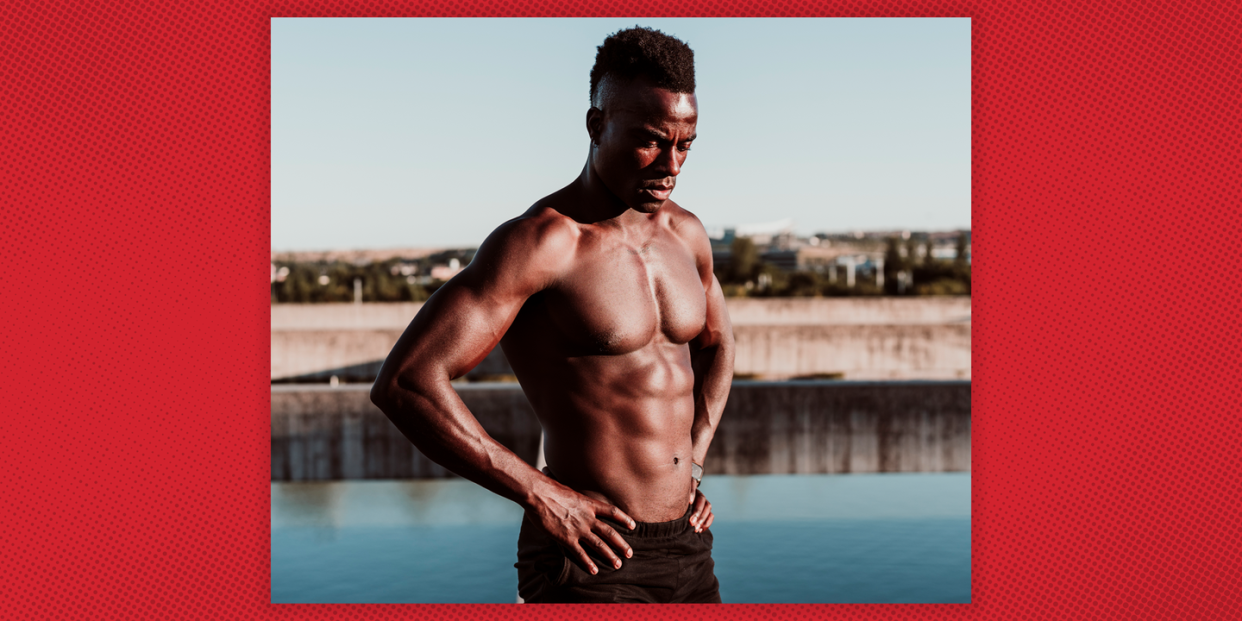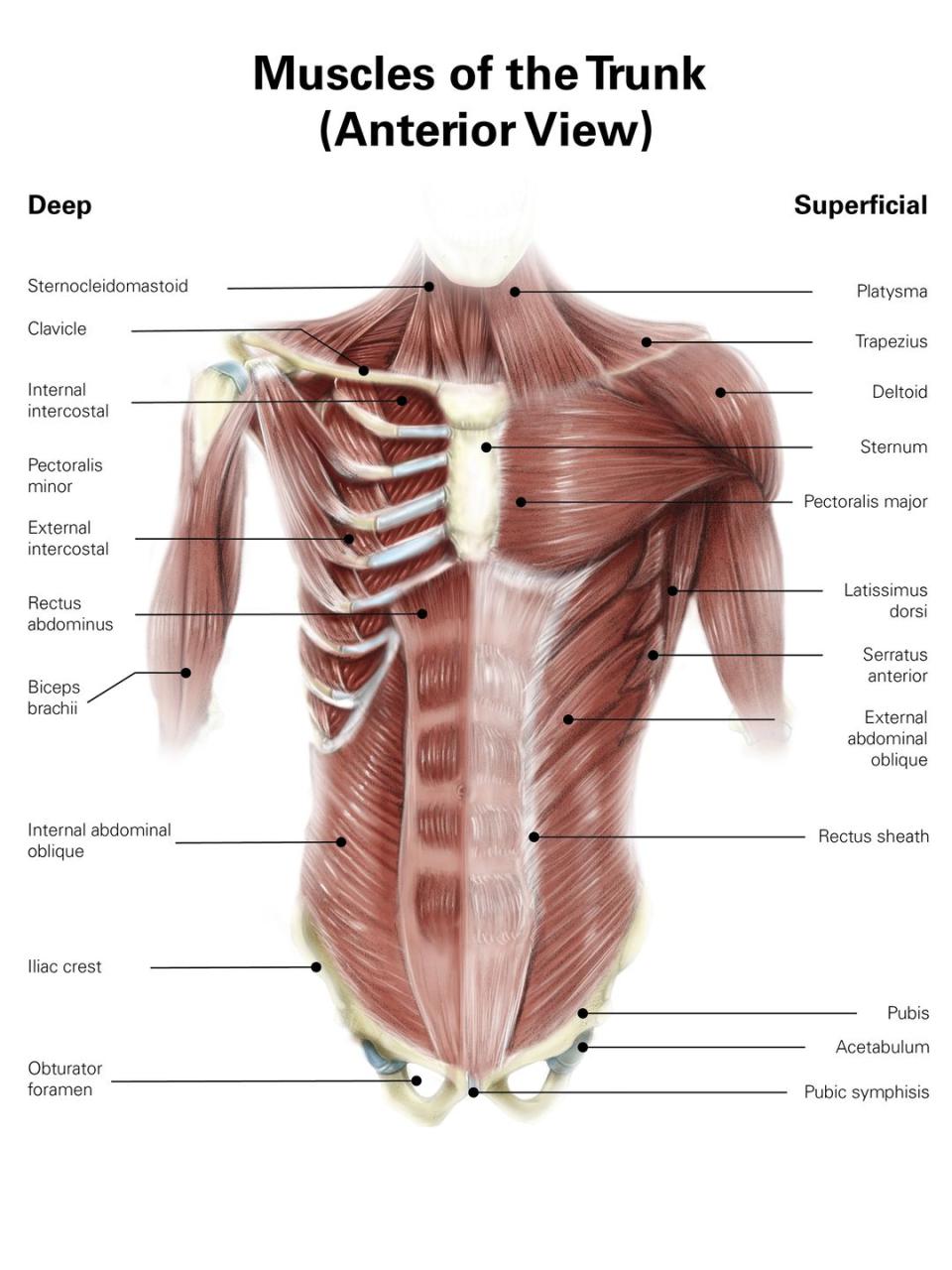What You Need to Know About Your 'Core 4' Ab Muscles

The following is an excerpt from the new Men's Health training guide 90-Day Transformation Challenge: Abs. In one volume, you'll get all the tools you need—information, a nutrition guide, and workouts—to build your abs in just 3 months.
One part of training I always tell clients is most important to realize right off the bat: the body is highly integrated. Your body is interconnected from the top of your head to the ends of your toes. This means everything you do in your workouts is a team effort. Particularly with ab training, most people look at isolating the abs as a way to “target” the muscles more effectively. But if you want to really train your abs, you’ll want to do it in a full-body approach.
When you work on just hitting abs, you are really focusing on how tightly you can have those muscles pull. This doesn’t seem like a bad thing—until you don’t know how to use your abs anywhere except the gym. A full-body approach lets you layer your core training into everyday movement. The benefits will expand well beyond your waist. No more lower back pain when you are going for a run. No more slouchy posture when standing around the office. No more second thoughts about whether your routine is working. Every core exercise used in this program is going to connect the core with the upper body, lower body, and backside. Not only that, all will burn significantly more calories than standard isolation moves: the more muscles you engage, the more work they do, and that results in increased calorie burn.
So how about I introduce you to the teammates that make up the abs. Let’s call them the Core Four. Your abs are made up of a bunch of different muscles, but the Core Four is probably what you picture when you think of a six-pack.
The Core Four Ab Muscles
Transverse Abdominis
The deepest of the four, this thin layer of muscle assists in supporting the lumbopelvic region (lower back and hips). The main responsibility of the transverse abdominis is to increase intra-abdominal pressure to promote stability at the midsection and assist in breathing, coughing, and other essential movements. Take a second to lay flat on your back and place your hand on your stomach. Now cough! That contraction you feel in your stomach? That’s your transverse abdominis, plus a few other muscles, at work.
Internal Obliques
One layer above the transverse abdominis, the internal obliques are a thin layer of muscle which spans the lateral side of the torso between the ribs and pelvis on each side of the abdomen. They are called “obliques” because of their odd shape. Their main role is to increase abdominal pressure. When both internal obliques are contracting, the upper body will flex forward. When one internal oblique is contracting, the body will bend to the contracting side.

External Obliques
The most superficial of the obliques, the external obliques span the lateral sides of your torso, with muscle fibers running downward and inward. The muscle function of the external obliques causes the trunk (shoulders to waistline) to flex when contracted on both sides. When the external oblique is contracting, it causes the body to bend toward the contracting side and rotate the trunk toward the opposite side. This is why you see people who are trying to develop their abs twisting so much. We will be adding plenty of rotation exercises to your program. We rotate in some way with every movement we make throughout the day. These exercises will put you in the fast lane to perform those movements with more strength, power, and ease.
Rectus Abdominis
The most superficial of the abdominal muscles, this long strap of muscle stretches from the sternum (chest plate) down to the pubis (bottom of the pelvis). Its main function is to flex the trunk. This muscle is interrupted by fibrous bands that create the look of a six-pack, which we will discuss in further detail later.
Posterior Ab Muscles
As I said earlier, the core is a 360-degree support to the midsection of your body. So it’s not just what you see on the surface level that’s working to keep you strong and upright. In fact, there are only a few muscles we can see in the mirror. The rest are deeper inside the body. They work as hard as the muscles you can see—and they need to be trained just as hard, too. Transverse abdominis, for example, is one of those deep muscles that play a huge role in our strength and movement, but it isn’t one of the visible core muscles we think of building up when we work on our abs.
On the posterior side (backside), there are also muscles that play a key role in abdominal function. Based on where your body is strongest, these workouts will lean more on preparing the muscles targeted within your routine to take the brunt of the work. If you have ever felt your backside, hips, or frontside leg getting tired during your ab routine, it may have been your posterior muscles picking up the slack. So let’s get an idea of what these muscles are and what roles they play in the body:
Quadratus Lumborum (QL): This is the square-shaped muscle connecting the bottom rib and the pelvis. The QL is responsible for lateral bending and extending the lumbar spine (lower back).
Psoas Major and Minor: Psoas major is the primary hip flexor, which works in conjunction with the next muscle we will discuss, the iliacus. Psoas minor is shorter and doesn’t cross the hip with psoas major, but they both work to flex the lumbar spine.
Iliacus: Part of the iliopsoas, the primary hip flexor group, iliacus plays a primary role in pulling the leg up and, on the other end, pulling the torso downward. If you have ever done abdominal exercises and felt a pull in your hip flexors, your iliacus was probably helping out. It doesn’t mean you aren’t working your abs; it just means you weren’t targeting the area you wanted.
Ultimately, your abs are comprised of a full team of muscles working together to stabilize your midsection. Let’s face it: your body was created with so many muscles in this region to provide you with support and to help you stay active and strong. So give the body what it wants! This workout plan will hit all of these muscles in different ways throughout the 90 days. Some of your ab days will feel grueling, while others—in the beginning—may make you wonder if you even worked your abs (trust me, you did). You’ll build all of these moves into a full-body approach that will leave your abs stronger and more defined than when you started.
You Might Also Like

